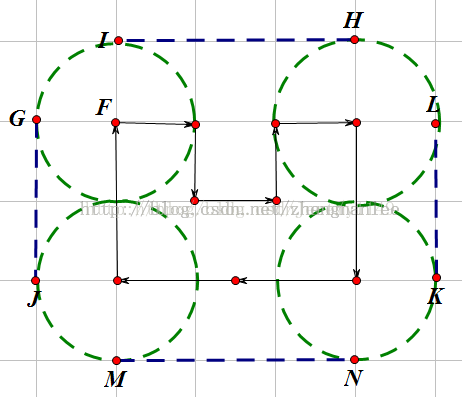81-POJ-Wall(计算几何)
| Time Limit: 1000MS | Memory Limit: 10000K | |
| Total Submissions: 41143 | Accepted: 14068 |
Description

Your task is to help poor Architect to save his head, by writing a program that will find the minimum possible length of the wall that he could build around the castle to satisfy King's requirements.
The task is somewhat simplified by the fact, that the King's castle has a polygonal shape and is situated on a flat ground. The Architect has already established a Cartesian coordinate system and has precisely measured the coordinates of all castle's vertices in feet.
Input
Next N lines describe coordinates of castle's vertices in a clockwise order. Each line contains two integer numbers Xi and Yi separated by a space (-10000 <= Xi, Yi <= 10000) that represent the coordinates of ith vertex. All vertices are different and the sides of the castle do not intersect anywhere except for vertices.
Output
Sample Input
9 100
200 400
300 400
300 300
400 300
400 400
500 400
500 200
350 200
200 200
Sample Output
1628
Hint
Source

证明:

先从简单的例子看起:假设现在的凸包有四个顶点构成,可以就一个顶点来观察,我们可以看到此处的周角由四个部分组成:2个直角,一个凸包内角,一个圆弧对应的圆心角。
同理每个顶点都有类似的关系,同时周角固定为360度,而凸包内角和为(4-2)*180 ;
所以总的圆弧对应的圆心角 = 4个周角 - 4 * 2个直角 - 4个凸包内角 = 4 * 360 - 4 * 2 * 90 - (4-2)*180 = 1440-720-360 =360度。
现在推广到n个顶点的凸包:
则所有内角和 = 周角 * n - n * 2个直角 - (n-2)*180 = 360*n - n *180 - n*180 + 360 = 360度。
故对于任意的凸包,所有的圆弧对应的圆心角之和都为360度,它们构成一个完整的圆。
ac代码如下:
#include <iostream>
#include <algorithm>
#include <cstring>
#include <cmath>
using namespace std;
#define N 10005
const double PI = acos(-1.0); int n,tot;//n为二维平面上点的个数,tot为凸包上点的个数
struct node {
int x,y;
}a[N],p[N]; //p[]用来储存凸包 double dis(node a1,node b1){ //两点间距离公式
return sqrt((a1.x-b1.x)*(a1.x-b1.x)+(a1.y-b1.y)*(a1.y-b1.y) + 0.00);
} //叉积:返回结果为正说明p2在向量p0p1的左边(三点构成逆时针方向);
//为负则相反;为0则三点共线(叉积的性质很重要)
double multi(node p0,node p1,node p2){ //
return (p1.x-p0.x)*(p2.y-p0.y)-(p2.x-p0.x)*(p1.y-p0.y);
} //极角排序:极角排序是根据坐标系内每一个点与x轴所成的角,逆时针比较。按照角度从小到大的方式排序
int cmp(node p1,node p2){ //极角排序;
int x=multi(p1,p2,a[0]);
if(x>0||(x==0&&dis(p1,a[0])<dis(p2,a[0])))
return 1;
return 0;
} void Graham(){ //求凸包
int k=0;
for(int i=0;i<n;i++) //找到最下最左的一个点
if(a[i].y<a[k].y||(a[i].y==a[k].y&&a[i].x<a[k].x))
k=i;
swap(a[0],a[k]); //将其设置为第一个点
sort(a+1,a+n,cmp);
tot=2,p[0]=a[0],p[1]=a[1]; //p[]模拟栈,用来储存凸包
for(int i=2;i<n;i++){
while(tot>1&&multi(p[tot-1],p[tot-2],a[i])>=0)
tot--; //右拐就回退
p[tot++]=a[i]; //左拐就放入
}
} double getArea(){
struct node b[3];
b[0] = p[0], b[1] = p[1], b[2] = p[2];
double area = 0;
for(int i = 2; i < tot; i++){
area += multi(b[0], b[1], p[i]) / 2.0;
b[1] = p[i];
}
return area;
} double getGirth(){
double rt = 0;
for(int i = 0; i < tot; i++){
rt += dis(p[i], p[(i+1)%tot]);
}
return rt;
} int main(){
double L;
while(cin >> n >> L){
tot = 0;
for(int i = 0; i < n; i++){
cin >> a[i].x >> a[i].y;
}
Graham();
double res = getGirth();
res += 2*PI*L;
cout << int(res + 0.5) << endl;
}
return 0;
}
81-POJ-Wall(计算几何)的更多相关文章
- POJ 1113 Wall(计算几何の凸包)
Description Once upon a time there was a greedy King who ordered his chief Architect to build a wall ...
- POJ 1556 计算几何+最短路
代码1: #include<iostream> #include<stdio.h> #include<string> #include<string.h> ...
- POJ 2954-Triangle(计算几何+皮克定理)
职务地址:POJ 2954 意甲冠军:三个顶点的三角形,给出,内部需求格点数. 思考:就像POJ 1265. #include <stdio.h> #include <math.h& ...
- poj 1410 计算几何
/** 注意: 千万得小心..就因为一个分号,调了一个晚上... **/ #include <iostream> #include <algorithm> using name ...
- poj 2653 计算几何
#include <iostream> #include <cstring> #include <algorithm> #include <cmath> ...
- poj 1269 计算几何
/** 判断直线位置关系 **/ #include <iostream> #include <cmath> #include <cstdio> using name ...
- poj 3304 计算几何
大意: 是否存在一条直线,使所有线段在直线上的投影至少交与一点 思路: 转换为是否存在一条直线与所有的线段相交,做这条直线的垂线,那么垂线即为所求 **/ #include <iostream& ...
- poj 2398 计算几何
#include <iostream> #include<cstdio> #include<cstring> #include <algorithm> ...
- BZOJ 1113 Wall ——计算几何
凸包第一题. 自己认为自己写的是Andrew 其实就是xjb写出来居然过掉了测试. 刚开始把pi定义成了int,调了半天 #include <map> #include <cmath ...
- POJ 3855 计算几何·多边形重心
思路: 多边形面积->任选一个点,把多边形拆成三角,叉积一下 三角形重心->(x1+x2+x3)/3,(y1+y2+y3)/3 多边形重心公式题目中有,套一下就好了 计算多边形重心方法: ...
随机推荐
- 利用OsCache实现后端轮循
轮循随处可见,最常用的是APP首页的一些促销活动,一两秒切换一张图片,让前端实现起来也不难.这里说下后端的轮循,实现原理是数组+缓存.将数组放入缓存,指定缓存失效时间,如果是在失效前从缓存中取数据,那 ...
- MVC涉及RouteTable自定义路径
Routing 到目前为止,我们已经解决了MVC的很多问题,但忽略了最基本的最重要的一个问题:当用户发送请求时,会发生什么? 最好的答案是“执行Action 方法”,但仍存在疑问:对于一个特定的URL ...
- SharePoint2013集成Exchange之任务同步
SharePoint可以将任务列表到outlook中,但在sharepoint 2013 上这个功能似乎不是很好用,如下图所示,点击任务列表的"同步到Outlook"按钮: 在弹出 ...
- kafka--通过python操作topic
修改 topic 的分区数 shiyanlou:bin/ $ ./kafka-topics.sh --zookeeper localhost:2181 --alter --topic mySendTo ...
- 干净的 js测试页面
<!DOCTYPE html><html lang="en" > <head> <meta charset="utf-8&quo ...
- 52道Python面试题
1.python中is和==的区别 Python中对象包含的三个基本要素,分别是:id(身份标识) .type(数据类型)和value(值).‘==’比较的是value值‘is’比较的是id 2.简述 ...
- Linux学习笔记 - Shell 输出命令
1. echo 命令 echo 是基本的shell输出命令,她的语法是: echo string 我们也可以使用她来定制一些输出的格式,具体如下: 输出普通字符串 echo "it is a ...
- 导入城市文件数据(csv)格式demo
页面: js: 后台:
- md5加密(3)---org.apache.commons.codec.digest.DigestUtils.md5Hex(input)
import org.apache.commons.codec.digest.DigestUtils;String sig = DigestUtils.md5Hex("str")
- 工具类MyBatisUtils创建SqlSessionFactory
package com.js.ai.modules.pointwall.interfac; import java.io.IOException; import java.io.InputStream ...
